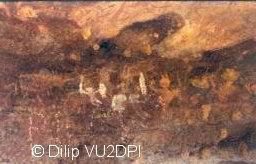Manikmoda
Manikmoda. 4 Kms
North-West of the erstwhile Hemagir feudatory estate. By far this is the largest
rock shelter discovered. This was
kept in use by its inhabitants for longer duration. Recovery of
varied microlith
and fragments of hand made
potteries point at longer and phased occupation of this rock shelter. There is a
perennial water-hole right at the middle of the rock shelter. A continues flow
of water dripping from the crevices stream down and form a small pool keeping
the area moist. Even stray vegetation and moss grow to keep the rock shelter
lively.
Resembling a serpent hood with layered crevices within its recesses, this rock shelter measures 89 Mets in length and 8 Mets in height. It has withstood the ravages of time paintings in monochromatic red ochre speak out they are of various shades and also in white. Sharp line drawings in red some only with outline and others filled are found in abundance. The figures depicted are bare out lines of human head with limbs, antelopes, humped bull intricate lines drawings in geometric shape are the most marked paintings on the walls of this rock shelter. The paintings of the earliest period can be clearly distinguished from the paintings of the later phases including the recent ones. This is discernible from the brightness of colour and the style of execution. Possibly the more recent ones are attempt at imitating the earlier ones.
 The sword
and shield wielding human figure and geometric patterns are well spread over a
large mural. Time span of the occupation of Manikmoda is from the Prehistoric to
the historic through the Protohistoric. Ornamentation and cladding of human
figures with identifiable equipment suggest the later phase. Another marked
feature here of the leaving style
of its occupants is the availability of several grinding holes and shallow pits
on the floor of the rock shelter. A
solitary engraving of a serpentine
shape measuring 2.50 Mets baffle all interpreters.
The sword
and shield wielding human figure and geometric patterns are well spread over a
large mural. Time span of the occupation of Manikmoda is from the Prehistoric to
the historic through the Protohistoric. Ornamentation and cladding of human
figures with identifiable equipment suggest the later phase. Another marked
feature here of the leaving style
of its occupants is the availability of several grinding holes and shallow pits
on the floor of the rock shelter. A
solitary engraving of a serpentine
shape measuring 2.50 Mets baffle all interpreters.
This rock shelter
has lost its pristine purity due to its closeness to current human habitation
and frequent visits by picnickers and State functionaries.
The recent visitors have not spared the rock shelter in leaving their imprints. Haematite is locally available and this has provided pseudo-artistic incentives to the modern visitors in defacing the ancient heritage. Self styled archaeologists and history hunters have burrowed through the floor in search of extinct signatures. And this has given Manikmoda the desolate look of a burial ground of the glorious past.